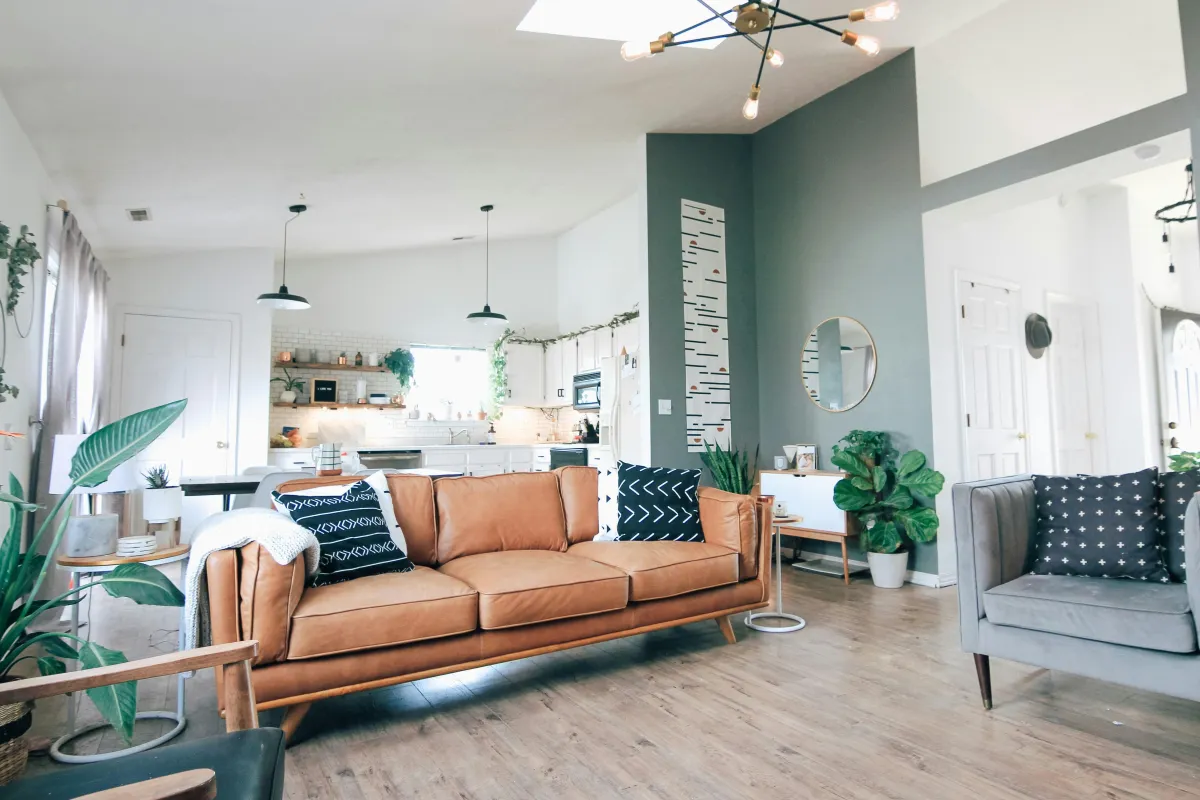
Your Guide to Smart, Stylish & Sustainable Home Designs
Custom home building requires careful planning and design to ensure every square foot works for its occupants. In Houston, TX, homeowners often face challenges choosing between layout planning and integrating sustainable and smart technologies. This article provides guidance by reviewing modern layout types that balance functionality with aesthetic appeal, effective room configurations, sustainable practices, smart home integration, cost management, and outdoor living enhancements, along with the latest design trends.
Key Takeaways
Modern custom home layouts balance functionality, sustainability, and design aesthetics.
Open-concept, split-level, ranch, and two-story layouts offer benefits such as efficient space use and enhanced accessibility.
Sustainable practices and smart home integration improve energy efficiency and long-term comfort.
Outdoor living areas expand functional space and quality of life.
Strategic cost planning and personalized design ensure the custom home-building process is both rewarding and efficient.
What Are the Key Types of Modern Custom Home Layouts?

Modern custom home layouts combine efficient space usage with thoughtful design. They often prioritize open movement, designated zones, and flexible areas that evolve with the homeowner’s needs. Each layout type offers a unique approach to managing flow, light, and functionality. The goal is to craft interiors that feel spacious, comfortable, and intuitive. These layouts also support energy-conscious designs and aesthetic preferences without compromising livability.
How Do Open-Concept Layouts Enhance Unique Living Spaces?
Open-concept designs create spacious interiors by removing walls between living, dining, and kitchen areas. These layouts improve movement, increase visibility, and maximize natural light, creating a bright and welcoming atmosphere. Homeowners enjoy flexibility for furniture placement and easy transitions between zones. Large windows and glass doors often link interiors to outdoor spaces, promoting ventilation and openness. This approach encourages interaction and makes entertaining guests more fluid. Open layouts are ideal for people who prefer minimalist designs with multi-functional zones. They also simplify heating and cooling efficiency. Such configurations support modern living priorities.
What Are the Benefits of Split-Level and Ranch Layouts?
Split-level layouts separate functional areas across staggered floors, offering clear zoning without isolating spaces. They use vertical separation to optimize movement between public and private zones. Ranch layouts, by contrast, span a single level, making them easy to navigate. Both styles support generous natural lighting and seamless indoor-outdoor connections through patios or decks. Their horizontal or tiered designs simplify construction while maximizing lot usage. These layouts are excellent for adapting to varied site elevations or accessibility needs. Split-level homes allow creative space division without enclosed rooms. Ranch homes support flexibility and open-air living.
How Do Two-Story Layouts Maximize Space and Functionality?
Two-story homes stack private zones above public ones, separating bedrooms and offices from gathering spaces. This vertical strategy improves privacy and maximizes usable land area. Noise control is enhanced, allowing simultaneous activity across levels. These designs offer adaptable future use, such as converting upstairs areas into guest rooms. Dedicated zones for heating and cooling support better energy management. Strategic placement of windows supports ventilation and natural light on both floors. Well-planned staircases and circulation routes ensure safe, intuitive movement. Two-story layouts balance privacy, space optimization, and long-term flexibility.
How Can You Design Functional Room Layouts in Custom Homes?

Functional room layouts are critical to maximizing comfort and usability in custom homes. Each space must reflect the homeowner's routine, support daily tasks, and allow for smooth transitions between zones. Layouts should consider lighting, ventilation, and access to other areas. Practicality, comfort, and aesthetics must work together. From open kitchens to quiet offices, thoughtful planning ensures rooms feel tailored, not generic. The right layout reduces wasted space while enhancing livability. It supports both current needs and future lifestyle changes.
What Are Best Practices for Modern Kitchen Layouts?
A well-designed kitchen begins with the work triangle—sink, stove, and refrigerator—placed to minimize steps and boost efficiency. Islands or peninsulas provide prep space and informal dining zones. Storage solutions like deep drawers and vertical shelves reduce clutter. Sustainable choices include LED lighting, low-emission materials, and water-saving fixtures. Open sight lines allow kitchens to connect with living spaces for better interaction. Flexible configurations support multitasking and accessibility. Wide pathways accommodate multiple users and mobility needs. Combining smart layout and eco-friendly features ensures a functional, modern kitchen.
How to Create Comfortable and Stylish Living Room Designs?
Comfortable living rooms combine aesthetics with purposeful design. Furniture should support relaxation while encouraging conversation, with layouts that promote natural flow. Lighting layers—ambient, task, and accent—enhance mood and function. Textures and tones can be used to define zones or add warmth. Large windows or sliding doors connect interior spaces with outdoor areas. Built-in media solutions and organized storage keep the space clutter-free. Seating arrangements must support both quiet evenings and social gatherings. Thoughtful design elevates everyday use while reflecting personal style.
What Are Innovative Home Office Layout Ideas for Remote Work?
Modern home offices prioritize focus, comfort, and adaptability. Placing offices away from high-traffic zones helps reduce distractions. Natural light and ergonomic furniture improve productivity and well-being. Adjustable desks, efficient cable systems, and integrated storage keep the workspace organized. Smart features such as lighting control and noise-reduction tools add convenience. Clear separation from personal areas supports work-life balance. Flexible layouts can include dual-use zones, like a reading nook or guest area. Visual simplicity and functional zoning create a productive atmosphere tailored to remote work needs.
How Do Sustainable Practices Influence Modern Custom Home Layouts?

Sustainability is a core principle in custom home design layouts, focusing on reducing energy use, improving comfort, and lowering environmental impact. Designs often include features that support long-term efficiency and health. Orientation, insulation, and eco-friendly materials work together to create resilient homes. Energy use is optimized through smart layout planning and natural light access. Water conservation methods and ventilation strategies enhance overall sustainability. Materials and systems are chosen for their performance and longevity. Sustainable layouts adapt easily to changing needs, making them both practical and future-ready.
What Are Energy-Efficient Design Principles for Custom Homes?
Energy-efficient design starts with orientation and insulation. Homes are positioned to capture sunlight in cooler months and reduce heat gain in warmer ones. Insulated walls, ceilings, and floors stabilize indoor temperatures. High-efficiency windows and sealed ductwork prevent energy loss. Smart thermostats manage climate based on occupancy. Solar panels and other renewable systems offer long-term utility savings. Efficient lighting and appliances further reduce energy use. These principles create comfortable environments that respond to both climate and lifestyle needs. Together, they support sustainable living.
Which Eco-Friendly Materials Are Ideal for Unique Living Spaces?
Eco-friendly materials prioritize durability, renewability, and low environmental impact. Reclaimed wood, bamboo, and recycled metal bring character while reducing new resource demand. Insulation made from natural fibers improves energy retention and indoor air quality. Low-VOC paints and finishes limit chemical emissions. Green roofing and metal roofing options extend lifespan and offer energy benefits. Modern composites balance strength with sustainability. These materials contribute to a healthier indoor environment and long-term performance. Choosing wisely ensures that every layer of the home supports sustainability and comfort.
What Are Cost Considerations When Planning Modern Custom Home Layouts?

Cost planning is essential to balance vision and budget in modern custom home layouts. Factors like materials, labor, technology, and design complexity all influence the final price. Energy-efficient systems and sustainable materials may increase upfront costs but offer long-term savings. Budget flexibility allows room for upgrades that enhance property value and performance. Clear communication between homeowners and professionals ensures realistic expectations. Strategic planning helps prioritize features with lasting impact. Custom layouts also benefit from early estimates and ongoing cost tracking. This ensures the project stays on time and within budget.Custom Builder Connection works closely with homeowners to align their design vision with practical budget strategies, ensuring quality without overspending.
Which Factors Most Affect Custom Home Layout Costs?
Layout costs are influenced by the size of the home, design complexity, and materials used. Premium materials, smart technology, and structural features increase the total cost. Labor expenses vary depending on location and availability of skilled professionals. Environmental considerations may also affect structural reinforcements and compliance measures. Energy-efficient systems often require higher investment but reduce operating costs. Site conditions, such as slope or soil, impact foundation needs. Permits and unexpected changes can add to the total cost. All these elements must be accounted for in financial planning.
How to Balance Budget With Personalized Design and Quality?
Balancing budget and design involves choosing where to invest for maximum impact. Key areas include energy systems, insulation, and durable finishes. Opting for modular elements or phased construction spreads out expenses. Affordable alternatives to luxury finishes can maintain aesthetics. Layout efficiency helps reduce material waste and labor costs. Collaboration with experienced designers helps align vision with budget goals. Value engineering ensures performance without sacrificing style. Prioritizing long-term savings over short-term cuts yields better outcomes in custom builds.
How Can Outdoor Living Spaces Complement Modern Custom Home Layouts?

Outdoor living areas extend the home's functionality while enhancing comfort and lifestyle. Well-designed patios, kitchens, and lounges create spaces for relaxation and entertaining. Thoughtful transitions between indoor and outdoor areas improve flow and usability. Durable materials and weather protection increase year-round use. Features like shading systems and energy-efficient lighting boost sustainability. Landscaping with native plants reduces maintenance and supports local ecosystems. These spaces offer a personal retreat without leaving home. They also increase overall property appeal and long-term value.
What Are Popular Outdoor Kitchen and Patio Layout Ideas?
Outdoor kitchens are often equipped with built-in grills, prep counters, and weather-resistant cabinetry. Durable materials like stainless steel and stone ensure longevity and easy maintenance. Patios are designed with flow in mind, creating natural pathways to indoor areas. Fire pits, dining zones, and integrated seating enhance usability. Lighting, fans, and heating options extend usage into evenings and cooler seasons. The layout often mirrors indoor zones to maintain visual consistency. Storage solutions keep supplies protected and accessible. These spaces merge practicality with comfort for daily living.
How to Design Functional and Inviting Outdoor Living Areas?
Designing outdoor areas requires attention to layout, materials, and comfort. Covered spaces like pergolas or retractable awnings offer sun and rain protection. Flooring options like composite decking and textured stone prevent slips and increase durability. Proper lighting enhances safety and ambiance after dark. Comfortable, weatherproof furniture encourages frequent use. Seamless doorways and matching design elements tie indoor and outdoor styles together. Smart irrigation and native plants minimize water use. Multi-use zones allow for dining, lounging, and recreation. The goal is to create a space that is beautiful and livable.
What Are the Latest Trends in Modern Custom Home Layouts?

Modern custom home layouts continue to evolve with changing lifestyle needs and design preferences. Current trends emphasize open-concept spaces, personalized features, and functional flexibility. Homeowners are prioritizing layouts that support work-life balance and long-term adaptability. There’s a growing demand for sustainable construction and smart technology. Spaces are being designed for multi-use, accommodating entertainment, wellness, and productivity. Visual simplicity, natural materials, and energy-efficient design remain popular. Outdoor-indoor flow is also prioritized for a more connected living experience. These trends align with the pursuit of comfort, value, and innovation.
Why Are Open-Concept and Flexible Spaces Increasing in Popularity?
Open and flexible layouts support a wide range of modern activities. Without fixed barriers, they allow light to travel freely and make rooms feel more expansive. Flexible zones can function as offices, gyms, or guest areas depending on changing needs. This adaptability suits families looking for long-term practicality. The design also enhances social interaction by unifying cooking, dining, and living spaces. Natural transitions to outdoor areas further expand usable square footage. This openness promotes healthier living through better airflow and daylight access. It balances daily functionality with aesthetic appeal.
How Are Personalized and Ergonomic Designs Shaping Unique Homes?
Home layouts now reflect individual comfort and performance needs. Ergonomic furniture and efficient spatial arrangements reduce strain and improve ease of movement. Adjustable lighting, built-in shelving, and intuitive room flow support daily routines. Personalized cabinetry, color schemes, and layout options give homeowners more control. Each room is designed for specific lifestyle activities, from wellness to remote work. Designers focus on making spaces comfortable without clutter. Smart features and voice controls further simplify daily tasks. This customization ensures long-term satisfaction and ease of use.
Frequently Asked Questions
What is the primary benefit of an open-concept home layout?
Open-concept layouts improve space efficiency and allow better natural light flow. They support seamless transitions between living, dining, and kitchen areas, enhancing everyday functionality and indoor-outdoor connectivity.
How do sustainable building materials impact the cost of a custom home?
Eco-friendly materials may require a higher upfront investment but deliver long-term savings through lower utility costs and reduced maintenance. They also contribute to healthier indoor environments and greater property value.
Why is smart home technology important in modern custom layouts?
Smart features like automated lighting, temperature control, and security systems offer convenience, energy efficiency, and adaptability. They make the home easier to manage and more responsive to daily routines.
What should be considered when designing an outdoor living space?
Outdoor areas should use weather-resistant materials, offer smooth flow from indoor spaces, and include elements like lighting, seating, and optional kitchens or fire pits to boost comfort and usability.
How can one balance cost with personalized design in custom home building?
Balancing cost means prioritizing impactful upgrades, using durable materials, and exploring modular or phased design options. Custom Builder Connection helps clients align their vision with budget-friendly solutions that maintain quality.
What are current trends in customized home layouts?
Today’s trends focus on flexible open layouts, ergonomic features, sustainability, and smart technology. These designs promote efficient living, aesthetic appeal, and adaptability for evolving lifestyle needs
How do two-story layouts contribute to space maximization?
Two-story designs separate private and shared zones vertically, optimizing land use and increasing privacy. This layout also supports efficient heating, cooling, and future layout flexibility.
Conclusion
Modern custom home layouts combine design, functionality, and sustainability to meet diverse lifestyle needs. By integrating flexible layout types, efficient room configurations, eco-friendly practices, and smart technologies, homeowners create spaces that are both dynamic and enduring. With careful cost planning and a focus on outdoor living, these homes remain adaptable, energy-efficient, and future-proof, providing a lasting blend of comfort and innovation. With guidance from experienced professionals like Custom Builder Connection, homeowners can bring together design, sustainability, and smart solutions in a seamless custom build.


